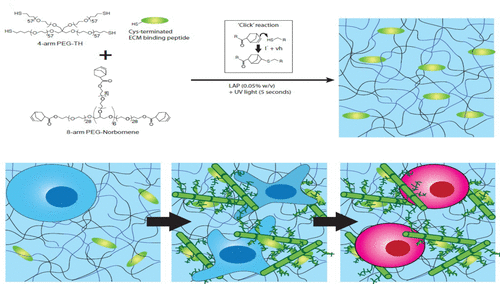当前位置:
X-MOL 学术
›
Biomacromolecules
›
论文详情
Our official English website, www.x-mol.net, welcomes your
feedback! (Note: you will need to create a separate account there.)
Encoding Stem-Cell-Secreted Extracellular Matrix Protein Capture in Two and Three Dimensions Using Protein Binding Peptides
Biomacromolecules ( IF 5.5 ) Pub Date : 2018-02-13 00:00:00 , DOI: 10.1021/acs.biomac.7b01482 Hadi Hezaveh 1 , Steffen Cosson 1 , Ellen A. Otte 1 , Guannan Su 1 , Benjamin D. Fairbanks 1 , Justin J. Cooper-White 1
Biomacromolecules ( IF 5.5 ) Pub Date : 2018-02-13 00:00:00 , DOI: 10.1021/acs.biomac.7b01482 Hadi Hezaveh 1 , Steffen Cosson 1 , Ellen A. Otte 1 , Guannan Su 1 , Benjamin D. Fairbanks 1 , Justin J. Cooper-White 1
Affiliation

|
Capturing cell-secreted extracellular matrix (ECM) proteins through cooperative binding with high specificity and affinity is an important function of native tissue matrices during both tissue homeostasis and repair. However, while synthetic hydrogels, such as those based on poly(ethylene glycol) (PEG), are often proposed as ideal materials to deliver human mesenchymal stem cells (hMSCs) to sites of injury to enable tissue repair, they do not have this capability—a capability that would enable cells to actively remodel their local extracellular microenvironment and potentially provide the required feedback control for more effective tissue genesis. In this work, we detail a methodology that engenders poly(ethylene glycol) (PEG)-based two-dimensional substrates and three-dimensional porous hydrogels with the ability to capture desired extracellular matrix (ECM) proteins with high specificity. This “encoded” ECM protein capture is achieved by decorating the PEG-based materials with protein binding peptides (PBPs) synthesized to be specific in their binding of fibronectin, laminin, and collagen I, which are not only the most omnipresent ECM proteins in human tissues but, as we confirmed, are also secreted to differing extents by hMSCs under in vitro maintenance conditions. By encapsulating hMSCs into these PBP-functionalized hydrogels, and culturing them in protein-free maintenance media, we demonstrate that these PBPs not only actively recruit targeted ECM proteins as they are secreted from hMSCs but also retain them to much higher levels compared to nonfunctionalized gels. This novel approach thus enables the fabrication of encoded surfaces and hydrogels that capture cell-secreted proteins, with high specificity and affinity, in a programmable manner, ready for applications in many bioengineering applications, including bioactive surface coatings, bioassays, stem cell culture, tissue engineering, and regenerative medicine.
中文翻译:

使用蛋白质结合肽在二维和三维中编码干细胞分泌的细胞外基质蛋白质捕获
通过具有高特异性和亲和力的协同结合来捕获细胞分泌的细胞外基质(ECM)蛋白是天然组织基质在组织稳态和修复过程中的重要功能。然而,尽管通常提出合成水凝胶,例如基于聚乙二醇(PEG)的那些,是将人间充质干细胞(hMSCs)输送至损伤部位以进行组织修复的理想材料,但它们不具备此功能。一种使细胞能够主动重塑其局部细胞外微环境并潜在地提供所需的反馈控制以实现更有效的组织发生的能力。在这项工作中,我们详细介绍了一种方法,该方法可产生基于聚乙二醇(PEG)的二维底物和三维多孔水凝胶,并能够以高特异性捕获所需的细胞外基质(ECM)蛋白。这种“编码的” ECM蛋白捕获是通过用蛋白结合肽(PBP)装饰PEG基材料来实现的,这些蛋白被合成为对纤连蛋白,层粘连蛋白和胶原蛋白I的结合具有特异性,而纤连蛋白,层粘连蛋白和胶原蛋白I不仅是人类中最普遍的ECM蛋白组织,但是,正如我们证实的那样,hMSCs在不同的条件下也以不同程度分泌体外维护条件。通过将hMSCs封装到这些PBP功能化的水凝胶中,并在无蛋白的维持培养基中进行培养,我们证明了这些PBPs不仅可以主动募集靶向的ECM蛋白,因为它们是从hMSCs分泌的,而且与非功能化的凝胶相比,它们还能保持更高的水平。因此,这种新颖的方法使得能够以可编程的方式制造具有高特异性和亲和力的捕获细胞分泌蛋白的编码表面和水凝胶,从而可用于许多生物工程应用,包括生物活性表面涂层,生物测定,干细胞培养,组织工程和再生医学。
更新日期:2018-02-13
中文翻译:

使用蛋白质结合肽在二维和三维中编码干细胞分泌的细胞外基质蛋白质捕获
通过具有高特异性和亲和力的协同结合来捕获细胞分泌的细胞外基质(ECM)蛋白是天然组织基质在组织稳态和修复过程中的重要功能。然而,尽管通常提出合成水凝胶,例如基于聚乙二醇(PEG)的那些,是将人间充质干细胞(hMSCs)输送至损伤部位以进行组织修复的理想材料,但它们不具备此功能。一种使细胞能够主动重塑其局部细胞外微环境并潜在地提供所需的反馈控制以实现更有效的组织发生的能力。在这项工作中,我们详细介绍了一种方法,该方法可产生基于聚乙二醇(PEG)的二维底物和三维多孔水凝胶,并能够以高特异性捕获所需的细胞外基质(ECM)蛋白。这种“编码的” ECM蛋白捕获是通过用蛋白结合肽(PBP)装饰PEG基材料来实现的,这些蛋白被合成为对纤连蛋白,层粘连蛋白和胶原蛋白I的结合具有特异性,而纤连蛋白,层粘连蛋白和胶原蛋白I不仅是人类中最普遍的ECM蛋白组织,但是,正如我们证实的那样,hMSCs在不同的条件下也以不同程度分泌体外维护条件。通过将hMSCs封装到这些PBP功能化的水凝胶中,并在无蛋白的维持培养基中进行培养,我们证明了这些PBPs不仅可以主动募集靶向的ECM蛋白,因为它们是从hMSCs分泌的,而且与非功能化的凝胶相比,它们还能保持更高的水平。因此,这种新颖的方法使得能够以可编程的方式制造具有高特异性和亲和力的捕获细胞分泌蛋白的编码表面和水凝胶,从而可用于许多生物工程应用,包括生物活性表面涂层,生物测定,干细胞培养,组织工程和再生医学。











































 京公网安备 11010802027423号
京公网安备 11010802027423号